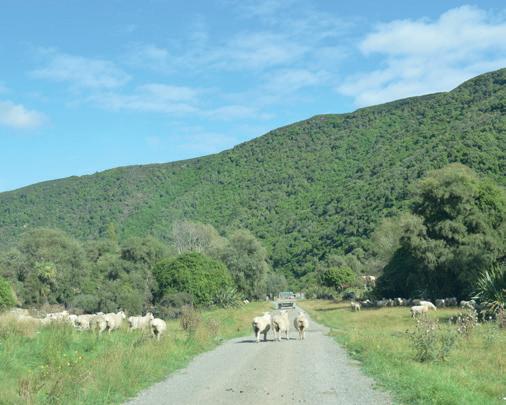
9 minute read
Special Feature – The big picture
THE BIG PICTURE

| Fifth-generation farmer Dan Studholme views himself as caretaker of the land for generations to come.
An intergenerational farming approach focusing on sustainability underpins Dan Studholme’s business strategy — across his dairy, sheep and beef operation in Waimate, South Canterbury.
As a fifth-generation farmer, Dan sees himself as a caretaker of the land as he juggles improving production while also enhancing the properties. The Studholme legacy began with Michael Studholme, a pioneering European settler who arrived in the area in 1854. In its heyday the Studholme’s Te Waimate landholding comprised around 100,000 acres. Across the generations the land has been broken up and sold, although Dan still has cousins farming next door and his family’s namesake town of Studholme is just down the road. Dan, his wife Bridget and children, Claudia and George live in a homestead on Te Mako. They also own Limestone Hills, about 7 kilometres away and lease another property, Vale Terrace 12 kilometres away. Dan has been back on the family farm for around 17 years, although as a kid he hadn’t necessarily planned on returning to the farm. After high school he completed a commerce degree at Otago University and then spent a short time travelling. At that time Dan described farming as ‘an unattractive proposition’. "Our family ownership structure was very complicated. There were several different ownership entities and intertwining historical loans. “My Dad Paul had been farming successfully in partnership with my grandfather and his sudden death led to the farming business coming under severe stress in the 1980s.
Homecoming
“I came home in 2004 and could see the potential in the farms but I also arrived as land prices started to skyrocket, which was a further complication.” Despite that, Dan went into partnership with his Dad and began an intense decade of fencing, fertilising and re-grassing.
| Some of the poorer performing land has been fenced off and planted in natives.


| Environmental sustainability is a key part of the Studholme legacy. “When I first came home none of the environmental measures we carry out now were even on the radar. It was all about making the most of your land and grazing. “We started fencing waterways in mid to late 2000s and the driver then was easier management. It was easier to re-fence or realign a fence, to stop stock getting stuck on the wrong side of the creek. It was about fencing off the worst land, so we could utilise the better land. “We began fencing off half and one-hectare areas, which we would leave to revert and sometimes plant in natives. “It became pretty clear that as well as a good farm management practice, there were additional environmental aspects around protecting the poorer ground. “Environmental sustainability is important to me, particularly because of the family legacy I'm involved in. The biggest constraint is budget. We have done a lot and made a lot of progress but it is a long journey.” Environment Canterbury, which Dan describes as one of the leading regional councils in the country in regard to their regional plan, has enabled them to be a lot further ahead than many along the environment journey. “We have had farm environmental plans for a number of years, as part of our irrigation consents and these are regularly audited. It’s just one less hurdle we have to contend with and means farming and land protection is less daunting for us than it is in some other areas.” Dan supports the principles of the Government’s waterway proposals and says there needs to be change but that common sense needs to prevail and change needs to be sensible.
Crown protection
The small waterway fencing Dan was carrying out was the catalyst to apply to the Queen Elizabeth II National Trust (QEII), to protect native land blocks. The QEII Trust is a statutory organisation, independent from the Government, that partners with private landowners to protect natural and cultural heritage sites on their land with covenants. The agreement protects the land forever, with around 180,000ha of private land now under QEII covenant. Partnerships have created a growing network of over 4,700 protected areas, ranging from small backyard patches to huge swathes of high country. Dan has three blocks protected by QEII, two 12ha blocks and one 17ha block, with the QEII Trust contributing half the $100,000 cost of fencing across the three blocks. “The carrot is receiving the funding that contributes to the cost of fencing. In my case these blocks were ineffective and the nature of the country meant full barrier fences in steep and rocky terrain was very expensive. “With support from QEII we have put aside over 40ha to allow native plants and wildlife to regenerate and the bonus for me is we can now further subdivide the areas around the QEII blocks, so we have improved grazing on the land that bounds the blocks.” With no stock grazing in the QEII blocks, Dan says there is a lot of undergrowth and seedling trees coming through, like totara and a lot more bird life.
Move towards dairy
Dan has also introduced a major change in stock composition over the years. When he came back to the farm, the stock make-up was a very traditional 80 percent sheep and 20 percent beef. Dairy support now makes up about 60 percent of land usage, with predominantly heifers grazed — sheep and beef cattle make up the remaining usage. “Over the last 15 years we have expanded into dairy support. Benefits include cash flow all year around, less price fluctuations, greater confidence in forecasted income and it frees up capital, so we don’t have as much money tied up in livestock. “It also adds a level of accountability. There are greater expectations to deliver when you are responsible for another person’s stock.” The home farm, Te Mako, comprises 185ha with 58ha of flat irrigated land, 40ha of easy to rolling and the remainder steep hill country. Limestone Hills, where Dan’s parents live, is 470ha with around 200ha of easy rolling land and the remainder hill country. The lease block, Vale Terrace, is a 280ha easy rolling property where the focus is on cattle — with about half the land irrigated. “We took on Vale Terrace about 4 years ago to give us more scale. “We try to build a flexible system by having a go at predicting what’s going to happen and making adjustments, so we are in a position to take the opportunities when they do arrive. Vale Terrace has given us additional scope to achieve that.”

| Dairy support makes up about 60 percent of land usage, with predominantly heifers grazed.



| Fattening lambs and beef cows make up a healthy mix of stock.
A healthy mix
A Romney ewe flock of 1,700 comprising two tooths, m/a ewes and 450 hoggets is run across the two owned blocks. The lambing percentage is around 150 percent and the average weaning weight is 28kg with a goal of bringing that up to 30kg or higher. Lamb sales vary each year. “It depends on the seasonal markets, weather and what other stock I am carrying through. “The last couple of years it has been profitable to sell the store lambs in December but this season I have kept the lambs for longer and fattened them on a specialist lamb feed which has worked well.” Studholme uses Romney rams sourced from George Williams’ Grassendale Stud in Wairarapa, a robust breed used to harsh conditions with proven growth rates. The hoggets are put to Southdown rams for quick maturing lambs which prime up quickly. The properties carry 130 Angus Hereford cross cows and along with a few buy-ins, finish 150-200 prime animals a year. Dan has focussed on finishing cattle rather than increasing breeding numbers, again to offer more flexibility into the system. “There is always potential to get better performance and we have been chipping away using different methods and being prepared to change the way we do things to get the best result.
Knowing the land
With an average annual rainfall across the properties of 700mm, having irrigation is a real bonus. During winter there are only ewe hoggets on Te Mako's 58ha of irrigated land but that land will be used to finish lambs and graze dairy heifers over the summer. "The irrigated land is almost treated like a dairy platform with a low stocking rate in the winter which is cranked up in summer. The soil type of the irrigated ground does not lend itself to wintering a lot of stock as it is quite poorly drained and I don't want to destroy good summer producing pastures over winter." Te Mako is on a community water scheme and pumps water from the neighbouring farm’s bore for troughs. Limestone Hills is spring fed using a combination of water storage tanks and gravity/solar reticulation. “Previously we relied on stock water through creeks and dams. As we have subdivided paddocks we have tapped into springs and reticulated that water to troughs. “So again, the driver wasn’t necessarily environmental but biodiversity is the winner. “It really depends on what spins your wheels and what your motivations for change are. “Most farmers have a hefty financial noose and they want to farm so they can loosen that noose and meet their commitments, while also moving forward in a sustainable way. “It’s about understanding the farm as an entire system. So, when you make a change you can understand the effect that has on the rest of the system, it’s about a more strategic approach to management so I’m always looking at the bigger picture. "I've always enjoyed trying to improve the land and make it produce more while also making it a better long-term proposition. Less environmental impact now is only going to make it a more sustainable business in the future. “We are always planning and looking at sustainability. For us a long-term plan is about thinking 100 years ahead, not 10 or 20 years. An example of this would be pine trees. A lot of our farm would be very suited to growing pine and in the current regulatory climate it would make sound financial sense. However, we feel that this would not be the best use long-term and we favour native plants and grazing for long-term financial and environmental sustainability.”
| Dan tries to build a flexible system by having a go at predicting what’s going to happen and making adjustments.
COOK UP A STORM WITH CHOICES REWARDS

Salter Electronic Mill 10,000 Points
Nutribullet 600W
31,400 Points
Assorted Cookbooks
FROM 11,200 Points


Breville the Toast Select Luxe 2 Slice or Soft Top Luxe Kettle
41,590 Points each
Salter Arc Electronic Kitchen Scale with Bonus Salter Timer
12,400 Points

Kenwood Multipro Classic Food Processor
94,800 Points
Gift Cards and e-Vouchers
FROM 12,500 Points
Keep an eye out for our Choices Rewards Specials – sizzling hot offers on rewards, available for a limited time.
Choices Rewards are exclusive to Farmlands shareholders only. Terms and Conditions apply. All Rewards are subject to availability. Required points values are subject to change. Visit www.farmlands.co.nz to learn more.










